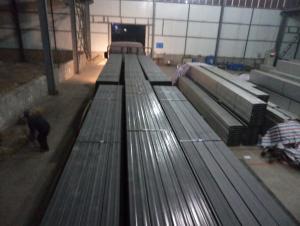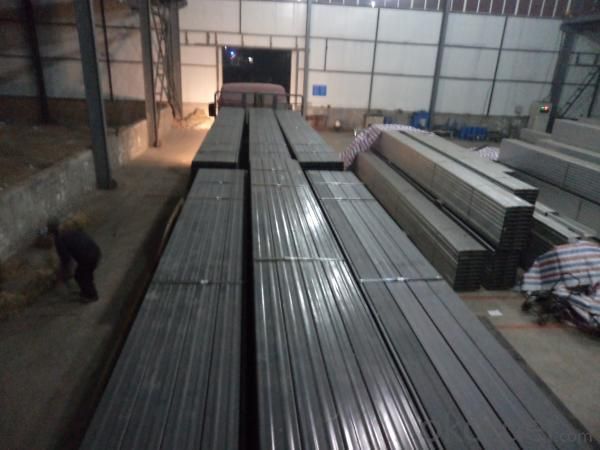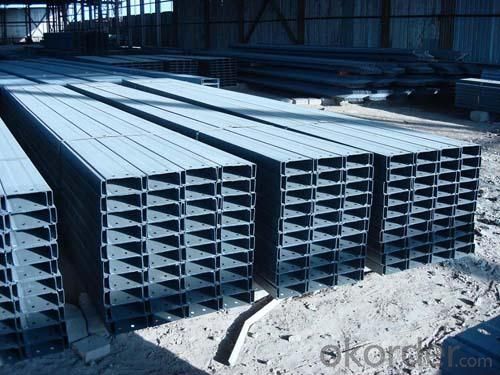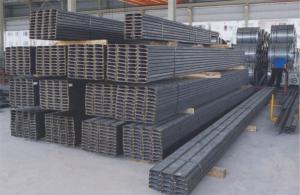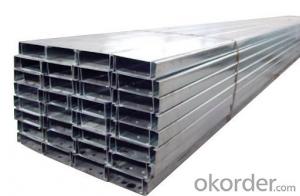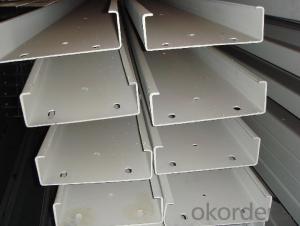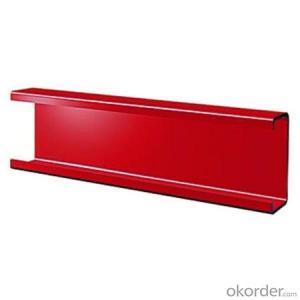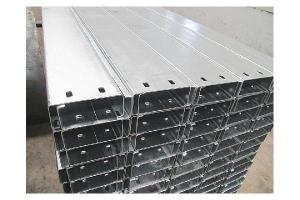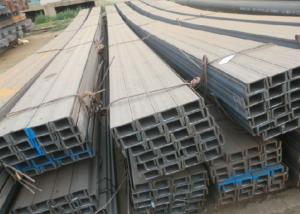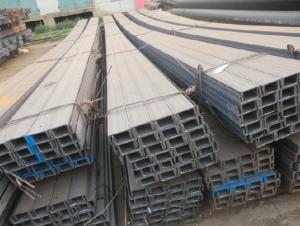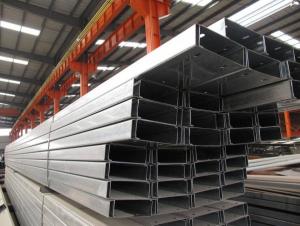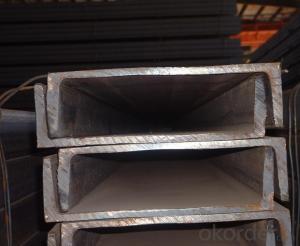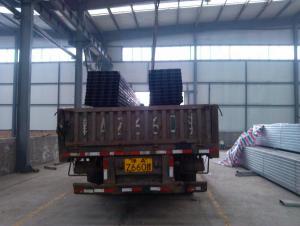CR Purlin C Channel
- Loading Port:
- Tianjin Port,China
- Payment Terms:
- TT or LC
- Min Order Qty:
- 20 Tons m.t.
- Supply Capability:
- 1000 Tons Per Month m.t./month
OKorder Service Pledge
OKorder Financial Service
You Might Also Like
Specifications of CR Purlin C Channel:
1. The detailed sections of CR Purlin C Channel as per GB standard.Just as followings in the table-1:
Size | Weight(kg/m) | Size | Weight(kg/m) |
80×40×20×2.5 | 3.925 | 180×60×20×3 | 8.007 |
80×40×20×3 | 4.71 | 180×70×20×2.5 | 7.065 |
100×50×20×2.5 | 4.71 | 180×70×20×3 | 8.478 |
100×50×20×3 | 5.652 | 200×50×20×2.5 | 6.673 |
120×50×20×2.5 | 5.103 | 200×50×20×3 | 8.007 |
120×50×20×3 | 6.123 | 200×60×20×2.5 | 7.065 |
120×60×20×2.5 | 5.495 | 200×60×20×3 | 8.478 |
120×60×20×3 | 6.594 | 200×70×20×2.5 | 7.458 |
120×70×20×2.5 | 5.888 | 200×70×20×3 | 8.949 |
120×70×20×3 | 7.065 | 220×60×20×2.5 | 7.4567 |
140×50×20×2.5 | 5.495 | 220×60×20×3 | 8.949 |
140×50×20×3 | 6.594 | 220×70×20×2.5 | 7.85 |
160×50×20×2.5 | 5.888 | 220×70×20×3 | 9.42 |
160×50×20×3 | 7.065 | 250×75×20×2.5 | 8.634 |
160×60×20×2.5 | 6.28 | 250×75×20×3 | 10.362 |
160×60×20×3 | 7.536 | 280×80×20×2.5 | 9.42 |
160×70×20×2.5 | 6.673 | 280×80×20×3 | 11.304 |
160×70×20×3 | 8.007 | 300×80×20×2.5 | 9.813 |
180×50×20×2.5 | 6.28 | 300×80×20×3 | 11.775 |
180×50×20×3 | 7.536 | ||
180×60×20×2.5 | 6.673 |
2.We supply high quality CR Purlin C Channel at reasonable price, including Chinese standard, Japanese standard and so on.
Standard | GB/JIS/EN/ASTM/DIN |
Material Grade | Q235B,Q235,Q345,Q345B,SS400,S235JRG1,A36,ST37-2 |
Technique: | Cold Rolled |
Sizes as per chinese standard: |
80×40×20×2.5 - 180×60×20×2.5
|
Sizes as per Japanese standard: |
180×60×20×3 – 300×80×20×3 |
Length: | 6meter, 9meter, 12meter |
Note: we are also competent to provide our customers other CR Purlin C Channel based on other sizes according to customer’s requirements.
Table-1
3. The chemical composition of CR Purlin C Channel according to Q235B is shown in Table-2.
Alloy No | Grade | Element(%) | ||||
C | Mn | S | P | Si | ||
Q235 | B | 0.12-0.20 | 0.3-0.7 | ≦0.045 | ≦0.045 | ≦0.3 |
Table-2
Note: we are able to present our customers relevant SGS test report for chemical composition of CR Purlin C Channel.
4. The mechanical property of CR Purlin C Channel according to Q235B is shown in Table-3-1 and Table-3-2
Alloy No | Grade | Yielding Strength Point(Mpa) | |||
Thickness(mm) | |||||
≦16 | >16-40 | >40-60 | >60-100 | ||
≧ | |||||
Q235 | B | 235 | 225 | 215 | 205 |
Table-3-1
Alloy No | Grade | Tensile Strength(Mpa) | Elongation After Fracture(%) | |||
Thickness(mm) | ||||||
≦16 | >16-40 | >40-60 | >60-100 | |||
≧ | ||||||
G235 | B | 375-500 | 26 | 25 | 24 | 23 |
Table-3-2
Note: we are able to present our customers relevant SGS test report for mechanical property of CR Purlin C Channel as customer’s request.
Applications of CR Purlin C Channel:
The CR Purlin C Channel can be applied to construction of warehouses, workshops, sport stadiums and car parks etc.The hot rolled channel steel belongs to carbon structural steel which is applied to in the field of construction and machinery.In details, the hot rolled channel steel is usually used for arch-itechtural structure, and they could be welded in order to support or hang a vari-ety of facilities. They are also usually used in combination with I beam. Generally,the hot rolled channel steel we supply must possess perfect welding property, riveting property and mechanical property and so on.
Package & Delivery of CR Purlin C Channel:
1.The hot rolled channel steel will be packed in bundle with steel wire at each end of every bundle and color marking in order to help the customer to recognize his goods more easily at sight.
2. And the hot rolled channel steel could be loaded into 20ft or 40ft container, or by bulk cargo.If the weight of each bundle reaches more than 3.5 mt, the loading by break bulk cargo should be choosed.When the weight of each bundle reaches less than 3mt, the loading by container should be choosed.
3.As for the transportaion from mill to loading port, the truck will be usually used. And the maximum quantity for each truck is 40mt.
4.All in all, we could do in accordance with customer's request.
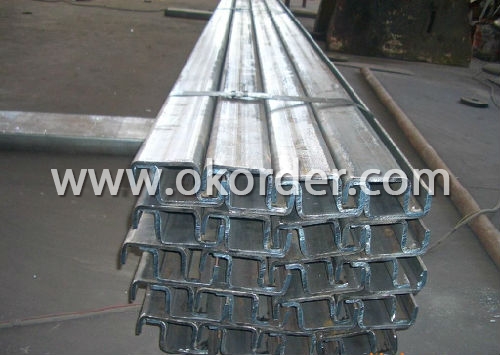
Production Flow of CR Purlin C Channel:
1.The steel billet shall be heated in the high temperature furnace.
2. The heated steel billet shall be rolled five to nine times with the aim of shaping the general figure of steel u channel.
3. The hot rolled channel steel should be put onto the cooling bed to make the temperature low.
4. The channel steel should be straighted on the straightener.
5. The straighted channel steel will be cut into meters by saw, as per customer's requirements.

- Q: How do steel channels contribute to the overall accessibility of a structure?
- Steel channels contribute to the overall accessibility of a structure in several ways. First and foremost, steel channels are often used as support beams or columns in the construction of buildings and bridges. These channels provide structural integrity and stability, allowing for the creation of open spaces and wide doorways that enhance accessibility. Additionally, steel channels can be utilized to create ramps or walkways that facilitate movement for individuals with mobility impairments. By using steel channels as the framework for these accessibility features, architects and engineers can ensure that they are strong enough to support the weight of wheelchairs or other assistive devices. Furthermore, steel channels are often employed in the construction of elevators and escalators, which are crucial elements for improving accessibility in multi-story buildings. These channels form the framework for the track systems that allow elevators and escalators to operate smoothly and safely, enabling people with mobility challenges to navigate between different levels easily. Moreover, steel channels can be used to create handrails or guardrails along staircases, ramps, or walkways. These safety features provide support and stability for individuals with disabilities or those who may have difficulty with balance, ensuring that they can move around the structure securely. Overall, steel channels play a vital role in the overall accessibility of a structure by providing structural support, facilitating the construction of ramps and walkways, enabling the installation of elevators and escalators, and creating safety features such as handrails and guardrails. These contributions enhance the accessibility of a structure, making it more inclusive and accommodating for individuals with disabilities or limited mobility.
- Q: The types of channel steels are 6, 8, 10, 12, 16, 20, 25, 32 and 14. What are their tensile strength of these types of channel steel?
- Tensile strength and yield strength are independent of size and size, but only material.
- Q: How do steel channels perform in seismic zones?
- Due to their exceptional performance under seismic loads, steel channels are widely used in construction in seismic zones. The shape of steel channels, characterized by their wide flanges and narrow depths, offers high strength and stiffness, making them resistant to lateral forces and vibrations caused by earthquakes. The ductility and high yield strength of steel channels enable them to dissipate and absorb seismic energy effectively. This means that they can undergo significant deformations without failing, allowing them to endure the intense ground shaking experienced during earthquakes. Moreover, the seismic performance of steel channels can be enhanced through design and reinforcement techniques. For instance, additional stiffeners or braces can be incorporated to improve their resistance to bending and torsion. These reinforcement methods help to distribute seismic forces more evenly throughout the structure, minimizing the risk of localized damage. Furthermore, steel channels have the advantage of being prefabricated, ensuring their manufacturing quality and accuracy. This facilitates efficient and precise installation, leading to reduced construction time and costs. In conclusion, steel channels have consistently demonstrated their reliability and effectiveness in seismic zones. The combination of their remarkable strength, ductility, and ability to dissipate seismic energy makes them the preferred choice for engineers and architects when designing structures in earthquake-prone areas.
- Q: What are the different types of reinforcements used with steel channels?
- There are several different types of reinforcements that can be used with steel channels. 1. Concrete: One common type of reinforcement is concrete. Steel channels are often embedded within a concrete structure to enhance its strength and load-bearing capacity. The concrete provides additional support and stability to the steel channel, making it more resistant to bending and flexing. 2. Steel Bars or Rods: Another type of reinforcement used with steel channels is steel bars or rods. These are commonly placed within the channel itself or along its edges to provide additional strength and rigidity. The steel bars or rods help to distribute the load evenly across the channel, reducing the risk of deformation or failure under heavy loads. 3. Brackets: Reinforcing steel channels with brackets is another common method. Brackets are typically made of steel and are used to connect and stabilize multiple channels together. They provide additional support and prevent the channels from twisting or moving out of alignment. Brackets can be welded or bolted onto the channels, depending on the specific application. 4. Welded Connections: Welding is another method used to reinforce steel channels. By welding additional steel plates or sections to the channel, the overall strength and stiffness can be increased. Welded connections are particularly useful in situations where the channels are subject to high forces or dynamic loads. 5. Reinforced Steel Sections: Reinforced steel sections, such as I-beams, are often used as reinforcements for steel channels. These sections are designed to provide maximum strength and load-carrying capacity. They can be attached to the channels using welding or bolting techniques, depending on the specific requirements of the application. In summary, there are several different types of reinforcements used with steel channels, including concrete, steel bars or rods, brackets, welded connections, and reinforced steel sections. These reinforcements enhance the strength, stability, and load-carrying capacity of the channels, making them more suitable for various construction and structural applications.
- Q: Standard for channel 20
- According to the GB / T 707 - 1998 hot-rolled steel GB, No. 20 channel is divided into: 20A; 20b two.20A: height: 200 mm width: 73 mm thickness: 7 mm weight: 22.637 kg / m theory.20b: height: 200 mm width: 75 mm thickness: 9 mm weight: 25.777 kg / m theory.(Note: the theoretical weight calculation of steel hot-rolled steel according to the density of 7.85 g / cm3)
- Q: Are steel channels suitable for use in warehouse storage systems?
- Indeed, warehouse storage systems can make effective use of steel channels. Steel channels offer a robust and enduring structure that can bear the weight of heavy loads within a warehouse. They possess the capability to withstand the pressure generated by diverse storage items, and can be employed in various storage arrangements, including pallet racking systems, shelving units, or mezzanine platforms. Steel channels exhibit resistance to harm, corrosion, and wear, thereby guaranteeing an extended lifespan for the storage system. Moreover, they can be conveniently personalized and altered to suit different storage requirements and configurations, rendering them a flexible option for warehouse storage systems.
- Q: How do steel channels contribute to the overall durability of a building?
- Steel channels contribute to the overall durability of a building in several ways. Firstly, they provide structural support by distributing the load evenly across different parts of the building, ensuring stability and preventing deformation. Additionally, steel channels have high tensile strength, allowing them to withstand heavy loads and forces, such as those caused by wind or earthquakes. They also enhance the building's resistance to corrosion and fire due to their non-combustible nature and protective coatings. Overall, steel channels significantly enhance the longevity and safety of a building, making it more durable and robust.
- Q: Can steel channels be used in bridge construction?
- Yes, steel channels can be commonly used in bridge construction. Steel channels are structural components made of steel that have a C-shaped cross-section. They offer high strength, durability, and versatility, making them suitable for various applications in bridge construction. Steel channels are often used as beams or supports in bridge construction because of their ability to withstand heavy loads and provide structural stability. They can be used as primary load-bearing members or secondary components to support other bridge elements. The use of steel channels in bridge construction offers several advantages. Firstly, steel channels have excellent strength-to-weight ratio, meaning they can provide high load-carrying capacity while being relatively lightweight. This results in cost savings during construction and reduces the overall weight of the bridge, leading to more efficient designs. Secondly, steel channels are resistant to corrosion, which is crucial for bridges exposed to harsh environmental conditions, such as bridges built near saltwater or in areas with high humidity. Steel channels can be galvanized or coated with protective layers to enhance their resistance to corrosion, ensuring the longevity and durability of the bridge structure. Furthermore, steel channels can be easily fabricated and customized to meet specific design requirements. They can be cut, welded, and shaped into various lengths and sizes to fit the bridge design. This flexibility allows engineers to create complex bridge structures that are both strong and aesthetically pleasing. In conclusion, steel channels are a commonly used component in bridge construction due to their strength, durability, and versatility. They provide structural stability, high load-carrying capacity, resistance to corrosion, and cost-effective solutions for bridge designs.
- Q: What are the guidelines for steel channel connections to concrete structures?
- The guidelines for steel channel connections to concrete structures involve several important considerations to ensure proper and secure installation. Here are some key guidelines to follow: 1. Design and Engineering: The connection details should be designed and engineered by a qualified professional to ensure structural integrity and safety. This includes determining the appropriate size and type of steel channel, as well as the required connection method. 2. Embedment Length: The steel channel should be embedded into the concrete structure at the recommended length to provide adequate support and prevent displacement or failure. The embedment length depends on factors such as the load requirements and the properties of the concrete. 3. Anchor Bolts: Anchor bolts are commonly used to secure the steel channel to the concrete structure. They should be properly sized, spaced, and installed according to industry standards and building codes. The tightening torque of the anchor bolts should also be checked to ensure a secure connection. 4. Welding: In some cases, welding may be used to connect the steel channel to the concrete structure. It is important to follow the appropriate welding procedures and techniques to achieve a strong and reliable connection. Welding should be performed by certified welders and inspected for quality and compliance. 5. Corrosion Protection: To prevent corrosion and prolong the lifespan of the connection, suitable measures should be taken. This may include applying protective coatings, using galvanized or stainless steel materials, or utilizing corrosion-resistant fasteners. 6. Load Distribution: The connection should be designed to distribute the load evenly across the steel channel and the concrete structure. This can be achieved through the use of appropriate connection methods, such as anchor bolts or welding, and ensuring that the load paths are properly aligned. 7. Testing and Inspection: After the connection is installed, it should be thoroughly tested and inspected to ensure its strength and integrity. Non-destructive testing methods, such as visual inspection or ultrasound, can be used to identify any potential defects or weaknesses. It is important to note that specific guidelines and requirements may vary depending on the project, local building codes, and the specific steel channel and concrete materials being used. Therefore, it is crucial to consult with a qualified engineer or structural designer to determine the most appropriate guidelines for each individual case.
- Q: The back of the channel steel deviates from the 30mm. The upper and lower iron plates are welded at intervals. Is the cross section resistance moment the sum of the two? No, is it big or small? Thank you
- The back of the steel channel deviates from the 30mm, and the upper plate and the lower iron plate are welded at intervals. Is the cross section resistance moment the sum of the two?" Must be greater than or equal to the sum of the two.
1. Manufacturer Overview
| Location | Tianjin,China |
| Year Established | 2006 |
| Annual Output Value | Above US$ 500 Million |
| Main Markets | China; Middle East; Southeast Asia; South America |
| Company Certifications |
2. Manufacturer Certificates
| a) Certification Name | |
| Range | |
| Reference | |
| Validity Period |
3. Manufacturer Capability
| a) Trade Capacity | |
| Nearest Port | Tianjin |
| Export Percentage | 40%-60% |
| No.of Employees in Trade Department | 11-20 People |
| Language Spoken: | English; Chinese |
| b) Factory Information | |
| Factory Size: | Above 50,000 square meters |
| No. of Production Lines | Above 3 |
| Contract Manufacturing | materials for processing; OEM Service Offered |
| Product Price Range | Average |
Send your message to us
CR Purlin C Channel
- Loading Port:
- Tianjin Port,China
- Payment Terms:
- TT or LC
- Min Order Qty:
- 20 Tons m.t.
- Supply Capability:
- 1000 Tons Per Month m.t./month
OKorder Service Pledge
OKorder Financial Service
Similar products
Hot products
Hot Searches
Related keywords


